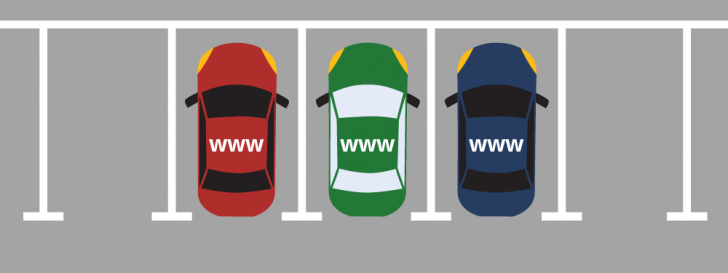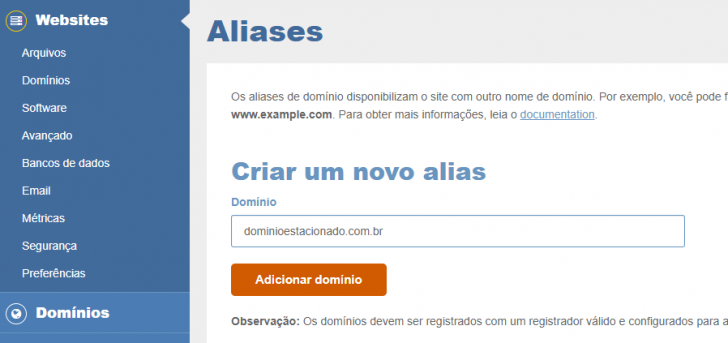

Registering multiple domains for your website can have various benefits, such as enhancing online visibility and safeguarding your brand from potential misuse by others. It would be disappointing to see a competitor’s website with a domain that closely resembles or mirrors your own, especially after the thought and effort put into selecting it carefully.
It would be difficult to clarify to customers that my websites surpass.com and my superstore.com.br are not affiliated, leading to potential financial losses. To prevent this, a simple and cost-effective solution is to register different domain variations.
A good idea for handling extra domains is to set them up as parked domains. Learn about parked domains, how to utilize them on your website, and the precautions to consider during setup.
What is a domain that is parked
A parked domain is an extra domain linked to the main website, enabling users to access the same content on both domains without redirection.
When setting up extra domains as parked, visitors will see the same content on any domain they access, be it the main one or any additional ones.
Why should I incorporate parked domains into my website?
Brand protection and user accessibility are key reasons for utilizing a parked domain.
It might be beneficial for brand protection to register domains similar to yours but with different endings. Coca-Cola, for instance, has registered various versions of its main domain (cocacola.com.br), including variations in the .com.br ending like coca-cola.com.br, as well as other endings such as cocacola.with and coke.with (with hyphen), among others.
Facilitating user access to your site involves mainly correcting typing errors. This can help users reach your site even if they make mistakes when entering the domain, thus protecting your brand from potential misuse.
Criminals frequently target banks and financial institutions by registering domain names closely resembling the genuine ones used by these institutions, such as bankbradescoo.com.br and bradescoinvest.com.br.
Using one or multiple parked domains on your website can help safeguard your brand and make it easier for users to access your site, especially in cases of typing errors.
In most situations, it is typically advised to redirect an additional domain to the main domain instead of utilizing a parked domain. There are various methods to perform a domain redirect, as detailed in this article. CloudFlare is a helpful and cost-free tool for domain redirection.
What sets apart a subdomain from a parked domain?
A subdomain is a section of a domain that is denoted by a point and precedes the domain name. Subdomains can be created using various combinations of letters and numbers within a domain.
The parked domain can be any address of your property and is not directly connected to the main domain. For example, abc.com and xyz.net could be parked domains of the same site without a subdomain relationship. The connection between them exists only in the content, which is identical across both domains as discussed earlier in this article.
Configuring a parked domain – How to set up a parked domain
Setting up a parked domain will vary depending on the hosting website being utilized. For lodging websites that utilize the cPanel control panel, you can park a domain by accessing either the Aliases or Parked Domains option. Access the relevant section to find a screen that looks like this:


Enter the desired domain in the Domain field on this screen, then click Add domain. A confirmation message will indicate that the parked domain has been successfully created.
Creating a parked domain in cPanel involves mirroring your main site’s content onto the new domain.
Upon revisiting the domain creation section, you will find the newly added domain listed there. If you’re using cPanel, you can set up a redirect for this domain to direct users to a different address, separate from the main domain.


Be cautious of duplicate content when dealing with parked domains and SEO.
When discussing parked domains, a crucial aspect is their impact on a website’s visibility in search engines, a process known as SEO (Search Engine Optimization). Major search engines like Bing, Yahoo, and especially Google play a significant role in this regard.
Google and other search engines penalize websites that show duplicate content, which has been published elsewhere, in order to prioritize sites that generate original content.
Setting up a parked domain on your website may be seen as duplicate content by search engines, potentially harming your site’s visibility.
There are methods to prevent this issue and indicate to Google and other search engines that the domains parked on your site are yours and not duplicate content. Below, we will explore two ways to address this problem and optimize your site for SEO.
Redirect the extra domain to the main one.
The easiest method to avoid parked domains being seen as duplicate content is to redirect the additional domain to the main domain, instead of just adding the parked domain and enabling navigation through multiple URLs.
Anyone attempting to enter the secondary domain will be redirected to the primary domain, preventing navigation through any other domain. For instance, when trying to access all overhosting. with, you will be automatically redirected to alloverhostingsites. com.br, the main domain.
There are various methods to redirect this kind. Typically, redirecting through the hosting control panel is straightforward. Other alternatives include modifying the server configuration file, like in the case of .htaccess for the Apache server. If you are unsure about the process, it is advisable to seek assistance from your hosting support team.
Use a link with the rel=canonical attribute to input the original URL as an option 2.
Google recommends that website owners utilize a specific link to indicate the original URL of their content to prevent it from being flagged as duplicate.
Simply insert a link type tag in the HTML header of the page (within the
and tags). This tag should have two attributes: rel=canonical to specify the link’s purpose, and href, which should include the original URL. This will generate a tag in the specified format.Even if the visitor accesses this page through the domain address com.br/example page, they will recognize that it is not duplicate content but a significant reflection of the main domain com.br/example page.
All website pages should include a tag that links to the original URL. Popular content management systems like WordPress provide plugins such as Yoast SEO to easily accomplish this. If your CMS does not offer this feature, reach out to your site developer to discuss the potential for implementing it.
It is a common and recommended practice in various situations, such as websites that can be accessed with or without www, through http and https, and when the same content is available through multiple URLs. For more information, refer to Google’s page on canonical URLs.
In conclusion
We discussed the definition and purpose of a parked domain in the article, as well as how to implement it on a website. We also explored the SEO implications of using this tool and highlighted easy methods to set up extra domains to prevent any optimization problems.
It is often more engaging to create a redirect for the extra domain, directing it to the primary one. For various methods to accomplish this, refer to the article on redirecting domains or pages.
Leave a comment if you need clarification or wish to contribute, and I will be happy to assist you.
Published on 06/09/2017 and revised on 25/08/2020.
Concepts labeled as Tags
